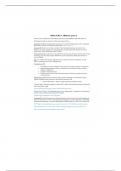MED SURG CARDIAC (part 3)
What are some complications of HF? Obesity, hypertension, hyperlipidemia, DM, AKI, ESRD, etc.
HF impairs the ability of ventricles to fill the heart and eject blood.
Risk factors: Problems with major blood vessels (ex: AA), MI/CAD/Atherosclerosis, Valve Congenital
Heart Defects, Infective/Acute/Subacute Endocarditis* (look on page 3*)
Goals for HF: Promote rest to reduce workload of heart and maintain adequate rest-activity ratio,
Efficiency of cardiac contractions by using medications, eliminate edema and congestion to prevent
further issues, assess hemodynamic status of patient.
Interventions for HF: Encourage rest, semi-high fowlers position, legs elevated to promote venous return,
O2 Therapy, strict I&O, daily weights, TEDS/SCD, Incentive Spirometer, C&DB, Stool softeners to
prevent straining
Diet: Low sodium, fluid restriction, high fiber and stool softeners to prevent constipation, no milk,
cheese, canned foods, Severe HF <1000mg Na/day
Classification of HF:
1. No limitation on activity. Ordinary activity does not cause fatigue, dyspnea, or palpitations.
2. Slight limitation of physical activity. Comfortable at rest, but activity brings on fatigue,
dyspnea, or palpitations.
3. Limitation on physical activity.
4. Unable to carry out any activity without discomfort. Sx present at rest, physical activity
worsens the pain.
Manifestations of HF: dizziness, confusion, fatigue, exercise intolerance, cool extremities, oliguria,
dyspnea, tachypnea, edema, productive cough, crackles/wheezing, SOB
Systolic Heart Failure – Diastolic which includes right sided & left sided.
L.Sided “Lungs”: pulmonary congestion- edema, PND*, oliguria, decreased brain perfusion, tachycardia,
pink frothy sputum, cough
(Paroxysmal Nocturnal Dyspnea: worsens at night when lying down)*
R.Sided “Rest of Body”: JVD, dependent edema, ascites, hepatomegaly*, weight gain, liver dysfunction,
anorexia, nausea, abdominal pain, generalized weakness
(Hepatomegaly enlargement of liver. RUQ pain)*
Diagnosing HF: Echocardiogram used to determine Ejection Fraction (amount of blood being dispersed
into body) Normal EF is 55-65%. Radionuclide Ventriculography, Xray, EKG, Electrolytes, CBC, BNP*,
Hemodynamic Monitoring, C-Reactive (inflammation), Cardiac Enzymes (r/o MI), TEE*, Cardiac Cath
BNP* high levels indicate high pressure in heart; Norm levels is <100, in HF this would be elevated.
CXR* determines size, position, contour of heart, can detect enlargement, fluid accumulation, etc.
EKG* measures the electrical conduction system of heart.
, TEE: transesophageal Echocardiogram: down esophagus to get better images of the heart, can determine
issues or if clots are present. Pre-Op: consent, NPO 6-8hrs, numbing agent given via gargle method or
spray. Post-op: HOB elevated, vitals, dyspnea, assess for gag reflex before PO! Sore throat is normal for
1-2 days post op.
Cardiac Catheterization*: insertion of a catheter into vein/artery from antecubital, groin or jugular access
and threaded into the heart; can be diagnostic/interventional purposes; Contrast is used* requires
puncturing of an artery, risk for bleeding @ the site is the first assessment* -Assesses blood flow and
pressures in the heart’s valves, chambers, and arteries-Used as an alternative to open heart surgery for
valvular issues or arterial occlusions. *Metformin should be held before Cardiac Catheterization
Nursing Interventions Pre-Op for Cardiac Cath: NPO 4-8 hrs before, outpatient procedure unless
hospitalized, contrast allergies, teach about procedure and how they might feel palpitations/asked to
C&DB. Hold Metformin 24-48hrs before/after. . pi
Nursing Interventions Post-Op for Cardiac Cath: observe for bleeding/hematoma, assess peripheral pulses
in the affected extremity (1st hour- Q15min, then 2nd hour- Q30min, then Q4H), neurovascular assessment,
screen cardiac monitor for dysrhythmias, bedrest 2-6 hrs post op, report chest pain, monitor contrast
effects and increase hydration, ensure safety.
*Neurovascular assessment includes: color, warmth, pulse strength, sensation, movement, pain in the
extremity of access site.
-if a clot occurs, the affected limb will appear red, swollen, decreased capillary refill, pain
Hemodynamic Monitoring: -Patient on ICU/CCU unit / Central line place within vessels to monitor -done
for 72-96Hrs or less, based on policy of facility. This is because the increased risk of infection aka
CLABS (Central Line Associated Blood Stream Infection)-Accessed via central venous access: jugular,
subclavian, or femoral. Placement of catheter confirmed via Xray. -Measures Central Venous Pressure: 2-
6mm Vena Cava/RA
-PAWP: Pulmonary Artery Wedge Pressure: LV function, site usually subclavian vein; Norm 6-15mm; HF
would be elevated
-Cardiac Output: Norm 3-8mm; decrease values would indicate HF.
More Norm Hemodynamic Values: CO=HRxSV 4-7L/min | CVP 2-6mmHg | SV 60-120mL/beat
Medications for Heart Failure:
ACE inhibitors (-pril), ARBS (-tan), BB (-lol), Nitrates, CCB (vnda), Cardiac Glycoside*, Diuretics,
Potassium
Cardiac Glycosides: Digitalis, Digoxin, Lanoxin: Slows the HR and improves perfusion to kidneys and
increase contractility. Used for HF, AFIB, and A-flutter. Increases SV and CO.
What does digoxin do? Increases the contractility and slows the heart rate.
Inotropic effect: increases force of contraction (Dig is a positive inotropic, negative chronotropic making
it slow the HR, and negative dromotropic)
Digoxin therapeutic Range 0.5-2 *Check potassium levels (norm 3.5-5) and apical pulse for 1 minute
prior to administration of drug. Hold med for HR <60.




